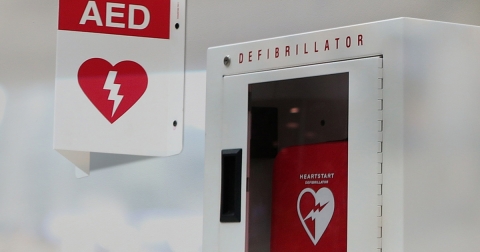Automatic External Defibrillators (AED) in Public Spaces

In recent years, the presence of automatic external defibrillators (AEDs) in public spaces like schools, athletic complexes, and even shopping malls has increased. An AED is a portable device that scans a person’s heart rhythm and sends an electrical shock to try and restore a normal heart rhythm. It is similar to the electric shock given by first responders or doctors, except that the device is designed for use by non-medical personnel and makes the decision on whether electrical shock is needed.
When a person collapses and is completely unresponsive, it is likely due to a sudden cardiac arrest, which means their heart is not pumping oxygen-rich blood to the brain and other organs. The use of bystander CPR and an AED, if available, greatly increase the person’s chance of survival.
If you witness someone collapse and become completely unresponsive, first call 911 or instruct someone nearby to call. Begin chest compressions by pushing hard and fast on the person’s chest to help circulate blood through their body. If an AED is available, instruct someone to go get it while you continue chest compressions. In schools or athletic settings, there will likely be individuals with AED training present. Whenever possible, someone who has been trained to use that specific AED device should take charge of AED use. However, untrained individuals can and have successfully used AEDs in emergency situations as well.
Attach the pads as shown in the AED illustrated instructions and follow the prompts to start the machine. It will scan the person’s heart rhythm and indicate whether or not a shock is necessary. Immediately after the shock is administered by the AED, the device will likely instruct you to continue CPR. While the AED may have been successful in restoring a normal heart rhythm, it’s critical to ensure that blood flow to the brain continues until medical personnel arrive.
About 80% of cardiac events occur in the home where AEDs are not typically available, but AEDs have increased the survival rates for individuals who experience sudden cardiac arrest in a public setting. Next time you are in a school, shopping mall, or other public space, pay attention to the location of AEDs, which are often mounted on the wall in visible locations. When emergency situations occur, knowing the location of an AED may save someone’s life.




